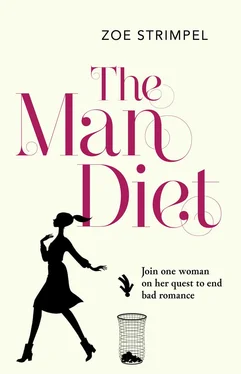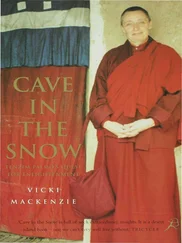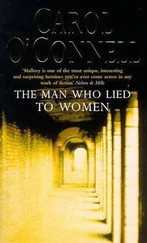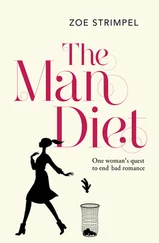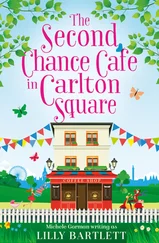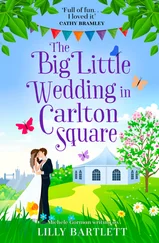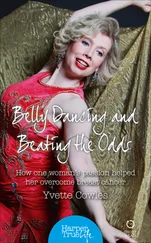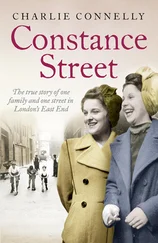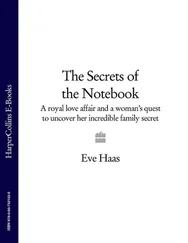Thirty-plus years after Gurley Brown showed us how a single girl can live – in a little apartment in the Village, having the odd affair, going out to dances with her girlfriends and working as a secretary at a man-tastic barge company – Sex and the City came along. It far more powerfully stamped an idea on our brains and an image on our retinas of how the single life should look – it should revolve around sex and men, a powerful, glamorous professional life, and lots of fun like shopping and drinking. New York writer Ariel Levy, a lover of the show just like I am, calls it a consumerist vision of ‘vertiginous gobbling’ that shows sex as something to be eaten up just like Manolos, cocktails and handbags. So seductive is its twinkling montage of intelligent girl chat, cosmopolitans, sanitised sex, wonderful clothes, great bodies, clinking glasses, hot restaurants and – most importantly – happy endings, that it was hard not to desperately want all that.
‘I’ll have an order of sex with that cocktail, please.’
‘Gobbling’ is indeed a good word for the SATC vision of sex. Meg Daly, a so-called ‘third wave’ feminist and author, has talked about Samantha-style sex in terms of the ‘swaggering pleasure’ that comes from counting the bed-post notches, and the joy of boasting about sexual techniques. Daly seems just as drawn to sex for the bragging rights as the pleasure of the act itself.
Recall the back slaps, bedpost notching and ‘bringing home the bacon’ attitude among my friends – are we merely gobbling men and sex, too? Sometimes it feels like it. Which is why, before I started the Man Diet, I felt like I was carrying around so much extra empty emotional weight. Gobbling will do that to a girl.
Mr Big: the ultimate NSA male
It’s also worth mentioning how the concept of closure is vilified in SATC – turning all sex, ultimately, into the strings-free variety. Yes, the Mr Right idea is the forceful, steady line drawn through the entire series – dangled, played with, and ultimately accepted. But as Joanna Di Mattia put it in her essay, ‘What’s the Harm in Believing?’: ‘It is a deconstruction of the Mr Right myth that enables romance to continue without closure.’ Ultimately, Carrie can’t deal with the closure Aidan offers – before she breaks away entirely, she tries to rebel, albeit feebly, by wearing the engagement ring around her neck. And, of course, she breaks into hives when trying on a white, frilly wedding dress. Mr Big, on the other hand, is constantly and obviously Mr Right waiting to happen. His defining characteristic, of course, is that he never offers real commitment. He’s so evasive, so no-strings that he doesn’t even have a name. Of course, Carrie’s resistance to romantic closure serves an important structural purpose: it makes way for years of single gal fun that we get to ogle. The impression is that closure and commitment get in the way of having fun and being wild.
And his female equivalent: the impossible Samantha
Carrie was never my favourite. Samantha was (and is). For years I cited her as the torch-holding feminist on TV. She was the only woman on TV who didn’t fall for slushy romance, ever reveal a true needy nature, nor desire the typical fairy tale marriage story. All this while exhibiting gobsmacking sexual appetite, without ever feeling low, used or at sea. In more recent times, I still adore Samantha, but I don’t try to emulate her now, because I realise she’s too good to be true. Or rather, she’s just not true and trying to be her was really not good for me.
‘Some have explained Samantha as basically a gay man in women’s Versace.’
Almost unsurprisingly, there is an academic course offered as a tie-in to the show, called ‘Sex and the City and the Contemporary Woman’. In the Samantha section of the syllabus, billed as ‘the sexual woman’, the first question posed is: ‘Is Samantha a liberated woman or a slut?’ What a wrong-headed binary to strap her into. The implication of this question is that, indeed, sexual profligacy alone will make you either a slut (I had hoped this old woman-hating notion was dying out) or ‘liberated’ (the point is that nowadays, liberation shouldn’t really have to do with how many penises enter your vagina – but, as per Walter and Levy, it has become an essential part of the definition). It gives a hell of a lot of credence – moral, social and political judgements are squeezed in between ‘slut’ and ‘liberated’ – to the act of sex. And to pop good old Sam in either category with any degree of earnestness is silly, once again betraying confusion about how to interpret the reality peddled by the show. Some have explained Samantha as the product of gay scriptwriters and producers on Sex and the City – that she is basically a gay man in woman’s Versace. Whatever – there are women writers too on the show, and she’s a fabulous character. It’s just that to see hers as an achievable type of lifestyle, parcelled in a box of imperturbable self-sufficiency, is to be deluded.
SATC: influential, or what?
Many of the women I spoke to said Sex and the City hadn’t influenced their actual way of behaving – and if they did identify with a character, few admitted it was Samantha (although one said ruefully she wanted to see herself as Carrie, but in reality she was probably more Samantha). But without doubt, SATC infiltrated female culture and its ideas of sex, fashion and urban lifestyle since it hit the air in 1998. One strong bit of research that explains why a mere TV show like SATC could actually impact the decisions women make – whether they admit it or not – was done by Albert Bandura, in 1977. He proposed Social Learning Theory, the idea that if you watch someone else do something, you can learn what rewards/consequences are attached to that behaviour (and thus if you should do it, how to do it). This research was innovative because Bandura found that watching a real person or a person on TV (as a character) doing something could be equally effective in observational learning. The different components of this ‘watch-and-learn’ model are Attention, Retention, Reproduction, Motivation. Your motivation reaches you through the rewards presented when you watched someone else do whatever behaviour.
According to Janet Kwok, who studies human development and education at Harvard, ‘Watching the ladies on Sex and the City find their happy endings despite participating in problematic behaviours was a large-scale social learning theory crisis, if we want to be dramatic. Their behaviour was easy to remember (Retention) and there were attractive rewards depicted (Motivation) without the potential consequences that might have been more representative of the viewers’ experiences.’
I’d add to Bandura’s theory and say that the fun of watching Sex and the City can be confused with the fun of actually doing what they do – i.e., have lots of no-strings, fun (if problematic, but ultimately brunch-analysed) sex. The problem is, while the SATC ladies proved to some extent that sex could result in the outcome most women desire (husband, kids, riches, happiness, success), we cannot always be assured of the same outcome. And our path to getting there will be all the rockier until we realise it’s not possible to be Samantha, either in numbers or approach. Or, for that matter, while we deny ourselves the right to bear strings.
The sex diarist: seductive mistresses of the strings-free shagathon
There’s another thing confusing our notion of ‘fun’ that is closer to home, perhaps, than the bars and bedrooms of Upper Manhattan. And that is the sex diarist, who romps the streets and clubs of London, and inhabits the pages of UK newspapers and the shelves of UK bookstores. I knew this culture of do-and-share a bit from the inside, since for one and a half years I was the Girl About Town dating columnist for thelondonpaper, a now-defunct but wildly popular evening freesheet. I was a novice, and at first I shared too much. People loved it when I did; all the same, I pulled back, feeling deeply awkward at the idea that everyone, from the Islamic extremist who threatened to kill me to my 12-year-old cousin, was reading about my exploits.
Читать дальше
